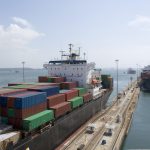
Brazil’s coastline is almost entirely made up of cliffs. This face, coupled with a dense jungle interior, has complicated and delayed Brazilian economic development for nearly all of its history. The bulk of Brazilian cities thus inhabit the thin coastal enclaves that sit below the highlands of the Brazilian shield. As seen in this shot, the favelas (slums) occupy the hillsides while the relatively wealthy portion of Rio proper exists around the narrow coastal strip near the port.
This geography also makes internal transport infrastructure—vital for a country as dependent on commodity and agricultural exports as Brazil—incredibly expensive. Road and railways attempt to compensate for the lack of navigable waterways, but the capital expenditure involved in setting up almost any economic enterprise of note means the ability to generate wealth will continue to be limited to the wealthy. Brazilian society is among the most unequal in the world in terms of wealth distribution, and its geography condemns it to remain so for the foreseeable future.
And even this ‘cheery’ forecast is likely overoptimistic. Brazil’s economic growth during the 1990s and 2000s was largely as a result of cheap international credit and open international markets – both of which are failing. The Brazilian economy stands on the edge of the abyss – as does the well-being of the country’s poor.



